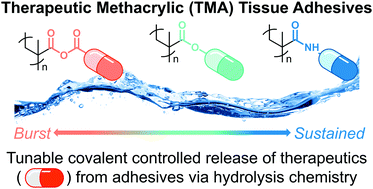Covalently-controlled drug delivery via therapeutic methacrylic tissue adhesives†
Abstract
Medical cyanoacrylate adhesives have the potential to eliminate the need for sutures but face challenges to widespread implementation due to their brittleness and release of formaldehyde upon degradation. To overcome these limitations, we used molecular design to create therapeutic methacrylic (TMA) monomers to impart tunable mechanical properties, decreased formaldehyde release, and covalently-controlled bioactivity to commercial cyanoacrylate adhesives. The small molecule therapeutics ibuprofen, acetaminophen, and benzocaine were covalently tethered to the carbonyl of methacrylate using anhydride, ester, and amide bonds. When these TMAs were incorporated into n-butyl cyanoacrylate (BCA) tissue adhesives, the resulting TMA–BCA materials provided release of the therapeutics across a range of time scales according to the reactivity of the tether bond to hydrolysis. The anhydride-tether TMA–BCA adhesive delivered ibuprofen on the same order of magnitude and time scale as topical medications (12 ± 6 mg per g adhesive after 3.4 h). TMA–BCA adhesives also produced less formaldehyde than standard BCA adhesive, showed promising cytocompatibility, and adhered effectively to porcine skin. Further, the anhydride, ester, and amide tether TMA–BCA adhesives exhibited a range of shear moduli, with those containing rigid aromatic amide groups being stiffer, and those with flexible alkyl segments being less stiff, which could enable these adhesives to be tailored to match the mechanical properties of target tissues. The amide-tether TMA–BCA adhesive also showed a 219% increase in toughness compared to BCA. Overall, TMAs represent a platform technology that can be used to build adaptable and bioactive tissue adhesives.

- This article is part of the themed collection: Journal of Materials Chemistry B Emerging Investigators


 Please wait while we load your content...
Please wait while we load your content...